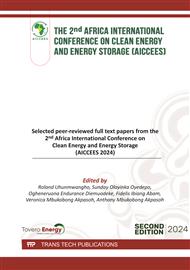p.65
p.85
p.121
p.141
p.155
p.165
p.175
p.195
p.205
Predictive Modelling for Optimizing Wind Turbine Performance and Structural Health Monitoring: Adapting Turkish SCADA Data for Sub-Saharan Africa
Abstract:
This research investigates the application of AI-enhanced structural health monitoring (SHM) systems to predict and optimize the performance and reliability of wind turbines in Sub-Saharan Africa power generation. Supervisory Control and Data Acquisition (SCADA) systems data from a Turkish wind turbine were leveraged to develop a predictive model using the eXtreme gradient boosting (XGBoost) algorithm. Wind speed data from the Turkish wind turbine was substituted with wind speed data of some selected locations in Sub-Saharan Africa (Katsina, Nigeria; Addis Ababa, Ethiopia; Dakar, Senegal; and Cape Town, South Africa). The performance of the models was evaluated using Mean Absolute Percentage Error (MAPE) and the coefficient of determination (R²). The findings show a 0.95% decrease in predicted power output for all the selected locations. The adapted model achieved a MAPE of 1.1% for Addis Ababa, 1.25% for both Cape Town and Katsina, and 1.17% for Dakar, while achieving a high R² of 0.96 for all the locations, indicating high predictive accuracy. In scenarios with high wind speed, Dakar has the highest prediction of 3691.09kW, achieving a 1.03% increase compared to Turkey with a predicted power output of 3583.69kW. Cape Town achieved better prediction accuracy, with a MAPE of 0.78% and R² of 0.98, while yielding a power output of 3545.67 kW. The model achieved F1-Score, Accuracy, sensitivity, precision, and selectivity scores of 99.87%, 99.75%, 99.93%, 99.81%, and 4.85% respectively. This study shows there is vast potential for employing machine learning models in enhancing the operational efficiency of wind turbines. Future study is recommended to incorporate local SCADA data across different wind farms in Sub-Saharan Africa.
Info:
Periodical:
Pages:
155-164
Citation:
Online since:
February 2025
Price:
Сopyright:
© 2025 Trans Tech Publications Ltd. All Rights Reserved
Share:
Citation:


